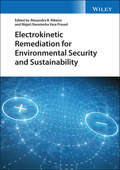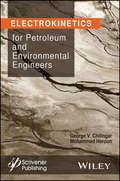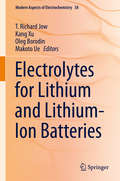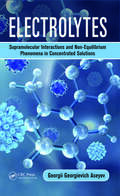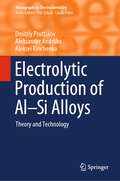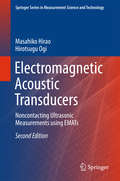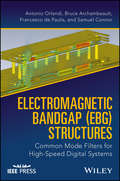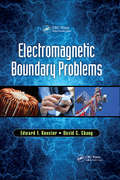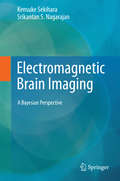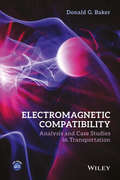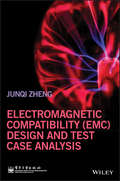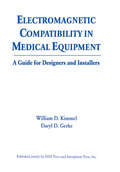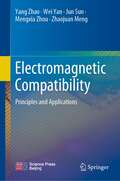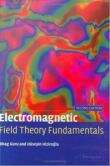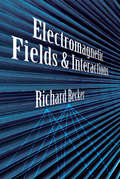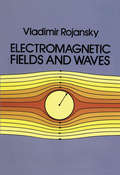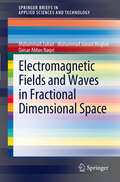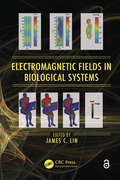- Table View
- List View
Electrokinetic Remediation for Environmental Security and Sustainability
by Alexandra B. Ribeiro Majeti Narasimha Vara PrasadExplore this comprehensive reference on the remediation of contaminated substrates, filled with cutting-edge research and practical case studies Electrokinetic Remediation for Environmental Security and Sustainability delivers a thorough review of electrokinetic remediation (EKR) for the treatment of inorganic and organic contaminants in contaminated substrates. The book highlights recent progress and developments in EKR in the areas of resource recovery, the removal of pollutants, and environmental remediation. It also discusses the use of EKR in conjunction with nanotechnology and phytoremediation. Throughout the book, case studies are presented that involve the field implementation of EKR technologies. The book also includes discussions of enhanced electrokinetic remediation of dredged co-contaminated sediments, solar-powered bioelectrokinetics for the mitigation of contaminated agricultural soil, advanced electro-fenton for remediation of organics, electrokinetic remediation for PPCPs in contaminated substrates, and the electrokinetic remediation of agrochemicals such as organochlorine compounds. Other topics include: A thorough introduction to the modelling of electrokinetic remediation An exploration of the electrokinetic recovery of tungsten and removal of arsenic from mining secondary resources An analysis of pharmaceutically active compounds in wastewater treatment plants with a discussion of electrochemical advanced oxidation as an on-site treatment A review of rare earth elements, including general concepts and recovery techniques, like electrodialytic extraction A treatment of hydrocarbon-contaminated soil in cold climate conditions Perfect for environmental engineers and scientists, geologists, chemical engineers, biochemical engineers, and scientists working with green technology, Electrokinetic Remediation for Environmental Security and Sustainability will also earn a place in the libraries of academic and industry researchers, engineers, regulators, and policy makers with an interest in the remediation of contaminated natural resources.
Electrokinetics for Petroleum and Environmental Engineers
by George V. Chilingar Mohammed HarounElectrokinetics is a term applied to a group of physicochemical phenomena involving the transport of charges, action of charged particles, effects of applied electric potential and fluid transport in various porous media to allow for a desired migration or flow to be achieved. These phenomena include electrokinetics, electroosmosis, ion migration, electrophoresis, streaming potential and electroviscosity. These phenomena are closely related and all contribute to the transport and migration of different ionic species and chemicals in porous media. The physicochemical and electrochemical properties of a porous medium and the pore fluid, and the magnitudes of the applied electrical potential all impact the direction and velocity of the fluid flow. Also, an electrical potential is generated upon the forced passage of fluid carrying charged particles through a porous medium. The use of electrokinetics in the field of petroleum and environmental engineering was groundbreaking when George Chilingar pioneered its use decades ago, but it has only been in recent years that its full potential has been studied. This is the first volume of its kind ever written, offering the petroleum or environmental engineer a practical "how to" book on using electrokinetics for more efficient and better oil recovery and recovery from difficult reservoirs. This groundbreaking volume is a must-have for any petroleum engineer working in the field, and for students and faculty in petroleum engineering departments worldwide.
Electrolytes for Electrochemical Supercapacitors (Electrochemical Energy Storage and Conversion)
by Jiujun Zhang Jinli Qiao Cheng Zhong Yida Deng Wenbin Hu Daoming Sun Xiaopeng HanElectrolytes for Electrochemical Supercapacitors provides a state-of-the-art overview of the research and development of novel electrolytes and electrolyte configurations and systems to increase the energy density of electrochemical supercapacitors. Comprised of chapters written by leading international scientists active in supercapacitor research
Electrolytes for Lithium and Lithium-Ion Batteries
by T. Richard Jow Kang Xu Oleg Borodin Makoto UeElectrolytes for Lithium and Lithium-ion Batteries provides a comprehensive overview of the scientific understanding and technological development of electrolyte materials in the last several years. This book covers key electrolytes such as LiPF6 salt in mixed-carbonate solvents with additives for the state-of-the-art Li-ion batteries as well as new electrolyte materials developed recently that lay the foundation for future advances This book also reviews the characterization of electrolyte materials for their transport properties, structures, phase relationships, stabilities, and impurities. The book discusses in-depth the electrode-electrolyte interactions and interphasial chemistries that are key for the successful use of the electrolyte in practical devices. The Quantum Mechanical and Molecular Dynamical calculations that has proved to be so powerful in understanding and predicating behavior and properties of materials is also reviewed in this book. Electrolytes for Lithium and Lithium-ion Batteries is ideal for electrochemists, engineers, researchers interested in energy science and technology, material scientists, and physicists working on energy.
Electrolytes: Supramolecular Interactions and Non-Equilibrium Phenomena in Concentrated Solutions
by Georgii Georgievich AseyevElectrolyte solutions play a key role in traditional chemical industry processes as well as other sciences such as hydrometallurgy, geochemistry, and crystal chemistry. Knowledge of electrolyte solutions is also key in oil and gas exploration and production, as well as many other environmental engineering endeavors. Until recently, a gap existed be
Electrolytic Production of Al–Si Alloys: Theory and Technology (Monographs in Electrochemistry)
by Dmitriy Pruttskov Aleksander Andriiko Aleksei KirichenkoThis monograph presents the theoretical background of the industrial process for the production of Al-Si alloys in standard aluminum electrolyzers. It reviews the physical chemistry and electrochemistry of cryolite melts containing silica and focuses on analyzing the exchange reactions in Na3AlF6–Al2O3–SiO2 melts. It presents the kinetics and mechanism of Si(IV) electroreduction in Na3AlF6–Al2O3–SiO2 melts on Al cathodes while the current yields as well as industrial tests performed are discussed. The modern research trends in the field are also overviewed. Providing readers with information not easily obtained in any other single source, this book is of great interest to researchers, graduates, and professionals working in the fields of electrochemistry and technology of cryolite-based melts.
Electrolyzed Water in Food: Fundamentals And Applications
by Tian Ding Deog-Hwan Oh Donghong LiuThis book provides fundamentals, highlights recent developments and offers new perspectives relating to the use of electrolyzed water (EW) as an emerging user- and environmental-friendly broad-spectrum sanitizer, with particular focus on the food industry. It addresses the generation, inactivation, pesticide degradation and safety of food by EW, illustrates the mechanism of the germicidal action of EW and its antimicrobial efficacy against a variety of microorganisms in suspensions. In addition, the sanitizing effects of combining EW with various chemical and physical sanitizing technologies have been evaluated, and recent developments and applications of EW in various areas including fruits and vegetables, meat, aquatic products, environment sterilization, livestock and agriculture has been described. The book can be a go-to reference book of EW for: (1) Researchers who need to understand the role of various parameters in its generation, the bactericidal mechanism of EW and its wide applications for further research and development; (2) Equipment producers who need comprehensive understanding of various factors (e.g. type of electrolyte, flow rates of water and electrolyte) which govern the efficacy of EW and developing its generators; (3) Food processors who need good understanding of EW in order to implement it in the operations and supervisors who need to balance the advantages and limitations of EW and ensuring its safe use.
Electromagnetic Acoustic Transducers
by Masahiko Hirao Hirotsugu OgiThis second edition provides comprehensive information on electromagnetic acoustic transducers (EMATs), from the theory and physical principles of EMATs to the construction of systems and their applications to scientific and industrial ultrasonic measurements on materials. The original version has been complemented with selected ideas on ultrasonic measurement that have emerged since the first edition was released. The book is divided into four parts: PART I offers a self-contained description of the basic elements of coupling mechanisms along with the practical designing of EMATs for various purposes. Several implementations to compensate for EMATs' low transfer efficiency are provided, along with useful tips on how to make an EMAT. PART II describes the principle of electromagnetic acoustic resonance (EMAR), which makes the most of EMATs' contactless nature and is the most successful amplification mechanism for precise measurements of velocity and attenuation. PART III applies EMAR to studying physical acoustics. New measurements have emerged with regard to four major subjects: in situ monitoring of dislocation behavior, determination of anisotropic elastic constants, pointwise elasticity mapping (RUM), and acoustic nonlinearity evolution. PART IV deals with a variety of individual issues encountered in industrial applications, for which the EMATs are believed to be the best solutions. This is proven by a number of field applications.
Electromagnetic Analysis and Design in Magnetic Resonance Imaging (Biomedical Engineering Ser. #1)
by Jianming JinThis book presents a comprehensive treatment of electromagnetic analysis and design of three critical devices for an MRI system - the magnet, gradient coils, and radiofrequency (RF) coils. Electromagnetic Analysis and Design in Magnetic Resonance Imaging is unique in its detailed examination of the analysis and design of the hardware for an MRI system. It takes an engineering perspective to serve the many scientists and engineers in this rapidly expanding field.Chapters present:an introduction to MRIbasic concepts of electromagnetics, including Helmholtz and Maxwell coils, inductance calculation, and magnetic fields produced by special cylindrical and spherical surface currentsprinciples for the analysis and design of gradient coils, including discrete wires and the target field method analysis of RF coils based on the equivalent lumped-circuit model as well as an analysis based on the integral equation formulationsurvey of special purpose RF coilsanalytical and numerical methods for the analysis of electromagnetic fields in biological objectsWith the continued, active development of MRI instrumentation, Electromagnetic Analysis and Design in Magnetic Resonance Imaging presents an excellent, logically organized text - an indispensable resource for engineers, physicists, and graduate students working in the field of MRI.
Electromagnetic Bandgap (EBG) Structures: Common Mode Filters for High Speed Digital Systems
by Samuel Connor Antonio Orlandi Bruce Archambeault Francesco De PaulisAn essential guide to the background, design, and application of common-mode filtering structures in modern high-speed differential communication links Written by a team of experts in the field, Electromagnetic Bandgap (EBG) Structures explores the practical electromagnetic bandgap based common mode filters for power integrity applications and covers the theoretical and practical design approaches for common mode filtering in high-speed printed circuit boards, especially for boards in high data-rate systems. The authors describe the classic applications of electromagnetic bandgap (EBG) structures and the phenomena of common mode generation in high speed digital boards. The text also explores the fundamental electromagnetic mechanisms of the functioning of planar EBGs and considers the impact of planar EBGs on the digital signal propagation of single ended and differential interconnects routed on top or between EBGs. The authors examine the concept, design, and modeling of EBG common mode filters in their two forms: on-board and removable. They also provide several comparisons between measurement and electromagnetic simulations that validate the proposed EBG filters' design approach. This important resource: • Presents information on planar EBG based common mode filters for high speed differential digital systems • Provides systematic analysis of the fundamental mechanisms of planar EBG structures • Offers detailed design methodology to create EBG filters without the need for repeated full-wave electromagnetic analysis • Demonstrates techniques for use in practical real-world designs Electromagnetic Bandgap (EBG) Structures: Common Mode Filters for High Speed Digital Systems offers an introduction to the background, design, and application of common-mode filtering structures in modern high-speed differential communication links, a critical issue in high-speed and high-performance systems.
Electromagnetic Boundary Problems
by Edward F. Kuester David C. ChangElectromagnetic Boundary Problems introduces the formulation and solution of Maxwell's equations describing electromagnetism. Based on a one-semester graduate-level course taught by the authors, the text covers material parameters, equivalence principles, field and source (stream) potentials, and uniqueness, as well as:Provides analytical solutions
Electromagnetic Brain Imaging
by Kensuke Sekihara Srikantan S. NagarajanThis graduate level textbook provides a coherent introduction to the body of main-stream algorithms used in electromagnetic brain imaging, with specific emphasis on novel Bayesian algorithms. It helps readers to more easily understand literature in biomedical engineering and related fields and be ready to pursue research in either the engineering or the neuroscientific aspects of electromagnetic brain imaging. This textbook will not only appeal to graduate students but all scientists and engineers engaged in research on electromagnetic brain imaging.
Electromagnetic Compatibility
by Donald G. BakerExplains and resolves the electromagnetic compatibility challenges faced by engineers in transportation and communications This book is a mathematically-rich extension of courses required to maintain the Federal Communications Commission (FCC), the Canadian Standards Association (CSA), and the European Union certifications. The text provides an in-depth study of the electromagnetic compatibility (EMC) issues related to specific topics in transportation and communications, including Light Rail Transit, shadow effects, and radio dead spots, through the analysis of real-world case studies in the United States and Europe. The author provides Cartesian, cylindrical, and spherical solutions that can be applied to Maxwell's and Wave Equations. The book covers topics such as SCADA Systems, shielding, and complexities of radio frequencies and their effect on communication houses. The author also provides information for alternative industries to apply the solutions from the case studies and background content to their own professions. Presents a series of over twenty real-world case studies related to EMC in transportation and communications Covers power line radiation, shadow effects on subway cars, train control systems, and edge distortions Includes the OATS testing method and Department of Transportation (DOT) test Provides access to a companion website housing power point slides and additional appendices Electromagnetic Compatibility: Analysis and Case Studies in Transportation is a reference for practicing engineers involved in transportation and communications, as well as post-graduate engineering students studying transportation and communications in engineering.
Electromagnetic Compatibility (EMC) Design and Test Case Analysis
by Junqi ZhengA practical introduction to techniques for the design of electronic products from the Electromagnetic compatibility (EMC) perspective Introduces techniques for the design of electronic products from the EMC aspects Covers normalized EMC requirements and design principles to assure product compatibility Describes the main topics for the control of electromagnetic interferences and recommends design improvements to meet international standards requirements (FCC, EU EMC directive, Radio acts, etc.) Well organized in a logical sequence which starts from basic knowledge and continues through the various aspects required for compliance with EMC requirements Includes practical examples and case studies to illustrate design features and troubleshooting Author is the founder of the EMC design risk evaluation approach and this book presents many years’ experience in teaching and researching the topic
Electromagnetic Compatibility in Medical Equipment: A Guide for Designers and Installers
by William D. Kimmel Daryl GerkeCo-published with the IEEE Press, this book is a practical, hands-on guide to EMC issues for medical device designers and installers. It addresses electromagnetic interference and covers the basics of EMC design, physics, and installation, minimizing theory and concentrating upon the correct way to ground and shield. Covering EMC from the inside out, the book provides the basics of electronics, discusses and evaluates problems and common causes, and explores effective remedial techniques at three levels: circuit, box, and interconnect. It contains appendices that provide important reference material such as constants and conversion factors.
Electromagnetic Compatibility: Principles and Applications
by Yang Zhao Wei Yan Jun Sun Mengxia Zhou Zhaojuan MengThis book highlights principles and applications of electromagnetic compatibility (EMC). After introducing the basic concepts, research progress, standardizations and limitations of EMC, the book puts emphasis on presenting the generation mechanisms and suppression principles of conducted electromagnetic interference (EMI) noise, radiated EMI noise, and electromagnetic susceptibility (EMS) problems such as electrostatic discharge (ESD), electric fast transient (EFT) and surge. By showing EMC case studies and solved examples, the book provides effective solutions to practical engineering problems. Students and researchers will be able to use the book as practical reference for EMC-related measurements and problem- solution.
Electromagnetic Computation Methods for Lightning Surge Protection Studies (Wiley - IEEE)
by Vladimir A. Rakov Yoshihiro BabaPresents current research into electromagnetic computation theories with particular emphasis on Finite-Difference Time-Domain Method This book is the first to consolidate current research and to examine the theories of electromagnetic computation methods in relation to lightning surge protection. The authors introduce and compare existing electromagnetic computation methods such as the method of moments (MOM), the partial element equivalent circuit (PEEC), the finite element method (FEM), the transmission-line modeling (TLM) method, and the finite-difference time-domain (FDTD) method. The application of FDTD method to lightning protection studies is a topic that has matured through many practical applications in the past decade, and the authors explain the derivation of Maxwell’s equations required by the FDTD, and modeling of various electrical components needed in computing lightning electromagnetic fields and surges with the FDTD method. The book describes the application of FDTD method to current and emerging problems of lightning surge protection of continuously more complex installations, particularly in critical infrastructures of energy and information, such as overhead power lines, air-insulated sub-stations, wind turbine generator towers and telecommunication towers. Both authors are internationally recognized experts in the area of lightning study and this is the first book to present current research in lightning surge protection Examines in detail why lightning surges occur and what can be done to protect against them Includes theories of electromagnetic computation methods and many examples of their application Accompanied by a sample printed program based on the finite-difference time-domain (FDTD) method written in C++ program
Electromagnetic Distance Measurement
by International Association of GeodesyElectromagnetic distance measurement, by using light and microwaves for direct linear measurements and thus circumventing the need for traditional methods of triangulation, may well introduce a new era in surveying. This book brings together the work of forty-eight geodesists from twenty-five countries. They discuss various new EDM instruments—among them the Tellurometer, Geodimeter, and air- and satellite-borne systems—and investigate the complex sources of error. The book is therefore a unique and comprehensive source on the subject. UNESCO and R.I.C.S. have assisted financially in its production.
Electromagnetic Field Near Conducting Half-Space: Theory and Application Potentials (Lecture Notes in Electrical Engineering #1070)
by Artur Zaporozhets Yuriy VasetskyThe book is devoted to the solution of one general problem of the theory of a three-dimensional quasi-stationary sinusoidal and pulse electromagnetic field. These studies, unlike many well-known works, are based on obtained exact analytical solution of the problem for the field, generated by external current sources near the conducting body with plane surface. The solution for the vector and scalar potentials, electric and magnetic intensities in the dielectric and conducting media is found without restrictions on the configuration of current sources,properties of the media and field frequency. Some general properties of field formation for arbitrary field in the considered system are obtained (in particular, full compensation by the field of the electric charge distributed on the interface between the media, the normal component of the induced external electric field and, accordingly, the equality to zero the components both of the current density and the electric field intensity perpendicular to the interface; the non-uniform electromagnetic field decreases in depth of conducting medium faster than uniform field). It is shown that the exact analytical solution depends on the values of the parameter proportional to the ratio of the field penetration depth to the distance between the external field sources and the body. The concept of strong skin effect is extended to the case of small value of the introduced parameter. A significant simplification of theexpressions was obtained as an asymptotic expansion on this small parameter. In the case of pulsed fields approximate method gives the highest accuracy during important initial period of pulse time. For asymptotic expansion the approximate impedance boundary condition is generalized to the diffusion of non-uniform field into conducting medium. The book is intended for the researchers, postgraduate students and students specialized in theory and calculations of electromagnetic fields.
Electromagnetic Field Theory Fundamentals
by Bhag Singh Guru Hüseyin R. HiziroğluGuru and Hiziroglu have produced an accessible and user-friendly text on electromagnetics that will appeal to both students and professors teaching this course. This lively book includes many worked examples and problems in every chapter, as well as chapter summaries and background revision material where appropriate. The book introduces undergraduate students to the basic concepts of electrostatic and magnetostatic fields, before moving on to cover Maxwell's equations, propagation, transmission and radiation. Chapters on the Finite Element and Finite Difference method, and a detailed appendix on the Smith chart are additional enhancements. MathCad code for many examples in the book and a comprehensive solutions set are available at www. cambridge. org/0521830168.
Electromagnetic Fields Excited in Volumes with Spherical Boundaries (Lecture Notes In Electrical Engineering #523)
by Victor A. Katrich Yuriy M. Penkin Sergey L. Berdnik Mikhail V. Nesterenko Victor M. DakhovThis book discusses the problem of electromagnetic wave excitation in spatial regions with spherical boundaries and the accurate mathematical modeling based on numerical and analytical methods to significantly reduce the time required for developing new antenna devices. It particularly focuses on elements and systems on mobile objects of complex shape that are made of new technological materials. The experimental development of such devices and systems is an extremely time-consuming, lengthy, and expensive process. The book is intended for senior and postgraduate students and researchers working in the fields of radiophysics, radio engineering and antenna design. The authors assume that readers understand the basics of vector and tensor analysis, as well as the general theory of electrodynamics. The original results presented can be directly used in the development of spherical antennas and antenna systems for the mobile objects. The book addresses problems concerning the construction of Green’s functions for Hertz potentials in electrodynamic volumes with spherical boundaries, and solves these clearly and concisely. It also uses specific examples to analyze areas where the results could potentially be applied. The book covers the following topics: · excitation of electromagnetic fields in coordinate electrodynamic volumes; · Green’s functions for spherical resonators; · Green’s functions for infinite space outside of spherical scatterers; · electromagnetic fields of dipole radiators on spherical scatterers; · electromagnetic fields of thin radial impedance vibrators on perfectly conducting spheres; · electrodynamic characteristics of narrow slots in spherical surfaces; · multi-element and combined vibrator-slot radiators on spherical surfaces.
Electromagnetic Fields and Interactions (Dover Books On Physics Series)
by Richard BeckerFor more than a century, "Becker" and its forerunner, "Abraham-Becker," have served as the bible of electromagnetic theory for countless students. This definitive translation of the physics classic features both volumes of the original text.Volume I, on electromagnetic theory, includes an introduction to vector and tensor calculus, the electrostatic field, electric current and the field, and the theory of relativity. The second volume comprises a self-contained introduction to quantum theory that covers the classical principles of electron theory and quantum mechanics, problems involving one and several electrons, radiation theory, and the relativistic theory of the electron. Based on research by the great Harvard science historian Gerald Holton, this book clearly explains Maxwell's and Dirac's field equations and contains a profound discussion and elegant use of the Helmholtz theorem on vector fields. Problems with solutions appear throughout the text, which is illuminated by 148 illustrations.
Electromagnetic Fields and Waves
by Vladimir RojanskyIntended for advanced undergraduate and graduate students, this well-known and popular textbook provides an introduction to the physical principles, mathematical apparatus, and typical applications of classical electromagnetic theory. Beginning with the notion of scalar fields, Professor Rojansky leads the student through vectors and vector fields, the laws of Ohm, Joule, Coulomb, and Faraday, static electricity, and continues all the way to Maxwell's equations for bodies at rest, and to examples of electromagnetic waves. A particularly useful feature of the book is the author's introduction and explanation of the necessary mathematics as he goes along, rather than presuming student understanding. Although an extensive background is not necessary, a general knowledge of physics and calculus is a prerequisite. Throughout the book, the development of each topic is explicit and unhurried, an approach intended to avoid basic misconceptions that lead to major misunderstandings later on. Short exercises help the student test his grasp of the material, and the text is studded with diagrams and illustrations that supplement the content and elucidate many hard-to-visualize concepts. The book ends at a point where the use of Maxwell's equations in several important problems has been illustrated, and students are prepared to proceed to a variety of further topics. Professor Rojansky brings many years of experience both as a teacher and a scientist (including ten years of advanced research at TRW Space Technologies Laboratories) to this lucid discussion of the fundamentals of electromagnetic fields and waves. His extensive pedagogical background enables him to communicate difficult concepts with great clarity.
Electromagnetic Fields and Waves in Fractional Dimensional Space
by Muhammad Zubair Qaisar Abbas Naqvi Muhammad Junaid MughalThis book presents the concept of fractional dimensional space applied to the use of electromagnetic fields and waves. It provides demonstrates the advantages in studying the behavior of electromagnetic fields and waves in fractal media. The book presents novel fractional space generalization of the differential electromagnetic equations is provided as well as a new form of vector differential operators is formulated in fractional space. Using these modified vector differential operators, the classical Maxwell's electromagnetic equations are worked out. The Laplace's, Poisson's and Helmholtz's equations in fractional space are derived by using modified vector differential operators.
Electromagnetic Fields in Biological Systems
by James C. LinSpanning static fields to terahertz waves, this volume explores the range of consequences electromagnetic fields have on the human body. Topics discussed include essential interactions and field coupling phenomena; electric field interactions in cells, focusing on ultrashort, pulsed high-intensity fields; dosimetry or coupling of ELF fields into biological systems; and the historical developments and recent trends in numerical dosimetry. It also discusses mobile communication devices and the dosimetry of RF radiation into the human body, exposure and dosimetry associated with MRI and spectroscopy, and available data on the interaction of terahertz radiation with biological tissues, cells, organelles, and molecules.
